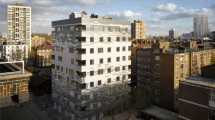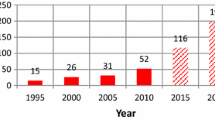Abstract
An equation for the participating width (elastic) of one-way orthotropic wood joist floor sheathing subjected to concentrated loading has been recently developed. The participating width is the length of sheathing normal to the span or parallel to the joists that is structurally involved in supporting the concentrated load. In this paper, the participating widths of 18-mm thick one-way simply supported oriented strand board sheathings with spans of 300 mm and 600 mm (span–thickness ratios of 16.7 and 33.3, respectively), determined by laboratory tests are reported. The experimentally determined participating widths appear consistent with the analytically predicted participating widths of the sheathings. In addition, it has been shown that the participating width in the linear elastic stage of behaviour is roughly equal to the participating width near maximum load. Subject to experimental validation by other types, thicknesses and spans of sheathing, the analytically derived participating-width equation is recommended in modelling wood joist floor sheathing for concentrated load performance assessment.
Zusammenfassung
Eine Gleichung wurde kürzlich entwickelt zur Berechnung der (elastischen) mitwirkenden Breite unter zentrischer Last von orthotropen Bodenplatten. Die mitwirkende Breite ist die Länge der Bodenplatten im rechten Winkel zur Spannweite, oder parallel zu den Balken der Konstruktion, die die zentrische Last stützen. In der vorliegenden Arbeit wird berichtet über mitwirkende Breiten von 18 mm dicken einbahningen, einfach gestützten OSB Verkleidungen mit Spannweiten von 300 und 600 mm (Spannweitenverhältnis von 16,7 und 33,3), welche mittels Laborprüfungen bestimmt wurden. Die so ermittelten mitwirkenden Breiten scheinen übereinzustimmen mit den theoretisch berechneten mitwirkenden Breiten der Platten. Zusätzlich wird gezeigt, dass das Verhalten der mitwirkenden Breite im linear elastischen Stadium ungefähr dem Verhalten der mitwirkenden Breite bei fast maximaler Last entspricht. Abhängig von der durch Versuche bestimmten Gültigkeit anderer Arten von Verkleidung, deren Dicke und Spannweite, wird die analytisch abgeleitete Gleichung für mitwirkende Breite empfohlen, um Modelle für Holzfußbodenverkleidung zur Bestimmung der Tragfähigkeit unter zentrischer Last zu entwickeln.

Similar content being viewed by others
References
APA (1976) Test methods and performance requirements for floor and roof sheathing. APA Research Report 135C, American Plywood Association (APA). Tacoma, Washington
ASTM (1988) Standard test method for performance of wood and wood-based flooring and roofing sheathing under concentrated static and impact loads. ASTM E661-88, American Society for Testing and Materials, Philadelphia
CEN (1992) Timber structures: testing of wood-based panels for determination of mechanical properties for structural purposes. EN 789, European Committee for Standardization, Brussels
CEN (1997) Timber structures—test methods—the performance of structural floor decking. preEN 1195, European Committee for Standardization (CEN), Brussels
Kearley VC, and Carruthers JG (1991) Assessment of the distribution and effects of concentrated loads applied to wood-based sheet materials. Report No. RD91204, Timber Research and Development Association, High Wycombe, Bucks
Moarcas O (1999) The measurement and modelling of the effects of concentrated loads on particleboard floor decking. PhD Thesis, Buckinghamshire Chilterns University College, High Wycombe, Bucks
Thomas WH (2001) Mechanical properties of structural-grade oriented strand board. Holz Roh- Werkstoff 59(6):405–410
Thomas WH (2003a) Models for designing oriented strand board floor decking with concentrated load. In: Proceedings of the 7th European panel products symposium, Llandudno, Wales, pp 159–170
Thomas WH (2003b) Models for concentrated load performance assessment of isotropic wood floor sheathing. J Struct Eng (ASCE) 129(8):1080–1086
Acknowledgements
The experimental work described in this paper was carried out at the University of Surrey, UK, as part of a program of research on the bending behaviour of oriented strand board under concentrated load. The technical assistance of Mr. Michael Jackman during the setting up of the test is gratefully acknowledged.
Author information
Authors and Affiliations
Corresponding author
Rights and permissions
About this article
Cite this article
Thomas, W.H. Experimental assessment of participating width of wood floor sheathing subjected to concentrated load: case study of OSB. Holz Roh Werkst 63, 38–42 (2005). https://doi.org/10.1007/s00107-004-0547-1
Published:
Issue Date:
DOI: https://doi.org/10.1007/s00107-004-0547-1




